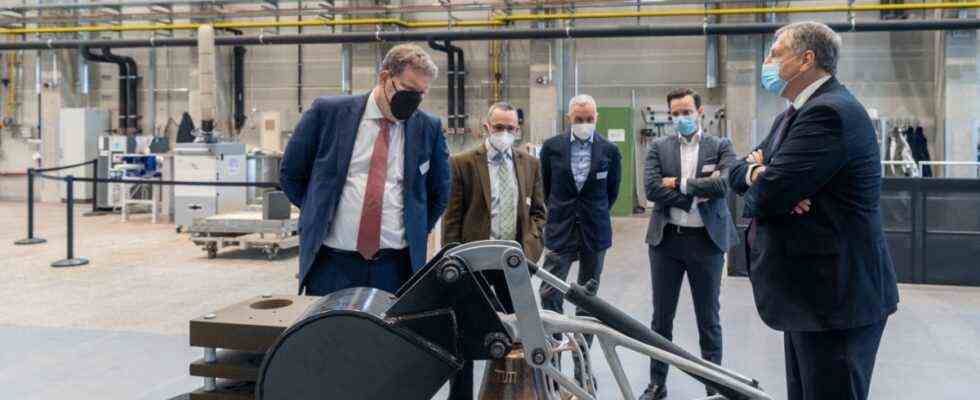The research landscape in Garching has one more institute: On the west side of the campus, the foundry pilot plant of the Fraunhofer Institute for Foundry Technology, Composites and Processing (IGCV) started its work. In the shiny, rectangular new building with a foundry hall, workshops, laboratories, offices and meeting rooms, a total of 23 employees research the latest developments in molding and casting processes, for example in the area of additive manufacturing or 3D printing, on around 1500 square meters.
In a current project, for example, they want to develop a new, extra-large 3D printer in cooperation with the companies GE Renewable Energies and Voxeljet, which should make it possible to manufacture central components of offshore wind turbines more quickly and in a more environmentally friendly manner.
The shiny, rectangular new building houses a foundry hall, workshops, laboratories, offices and meeting rooms on around 1500 square meters.
(Photo: Andreas Heddergott / Fraunhofer Institute)
Specifically, the 3D printer is to use the so-called binder jetting process to produce molds for metal casting components from quartz sand and the resin binder, which are then installed in GE’s Haliade-X offshore turbines. With the help of the printer, the molds, which weigh up to 60 tons and have a diameter of up to nine and a half meters, can be produced in just two weeks instead of the usual ten. Since the printer can be set up in the immediate vicinity of the future wind turbines, long transport routes are no longer necessary.
The binder jetting printing process is one of the main focuses of the foundry technology division of the IGCV and offers several advantages compared to the conventional production of casting molds with tools. “We can produce a wide variety of shapes, more complex and special than with tools,” explains Steffen Klan, head of the foundry department. For example, components could be adapted as precisely as possible to the topology of their location.
Like all Fraunhofer institutes, the IGCV also stands for making current research results directly applicable to industry. The field of foundry technology is particularly interesting for the automotive industry, as research is carried out here on the production of drive components or chassis parts made of metal, but metallic, cast components also play a central role in future industries such as wind power. Corona in particular has shown how important it is to be able to manufacture components yourself in Germany in order not to be dependent on foreign suppliers, says Klan. “With our processes, we are also able to manufacture large components at short notice.”
With the inauguration of the foundry pilot plant, the Fraunhofer campus on the Garching research site is growing: In addition to the IGCV, the Fraunhofer Institute for Applied and Integrated Safety AISEC is already located in Garching. The Fraunhofer Institute for Cognitive Systems (IKS) will be added by 2024. Klan sees the proximity to the university’s other natural science institutes with thousands of students as a great advantage of the new location. “Here you can think outside the box with little effort and have short distances,” he says.
The future issues also include the question of sustainability. The foundry industry uses a lot of energy and produces a lot of harmful emissions. How can the processing of metal and building with metal be designed in a way that conserves resources and uses less energy? One answer could be the keyword lightweight construction. But when it comes to the question of the building material you have to look carefully, Klan emphasizes: “I can also achieve a lightweight construction with iron and steel.”
An important goal for the researcher is to dispense with primary metals even more in the future and instead to reuse metals – such as aluminum – to a greater extent. Here, as with emissions, a lot will happen in the coming years, says Klan confidently – also in order to maintain the competitiveness of German foundries. “The industry is aware that it has to get involved in this regard. And customers are also driving this development forward. They are asking today: What CO₂ backpack do the components of a car bring with them?”

